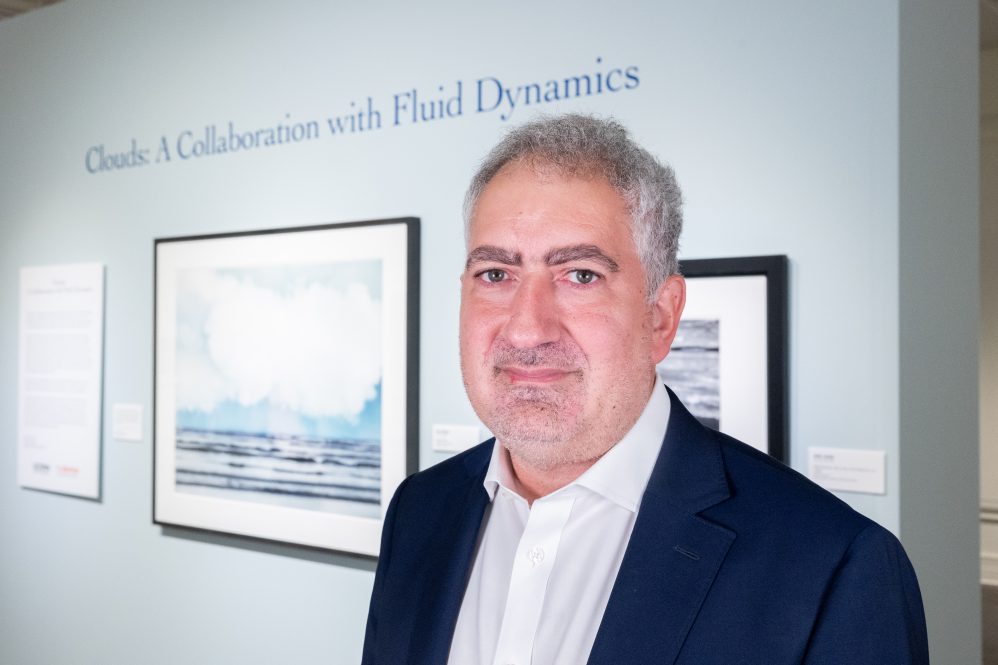
If an artist took a paintbrush, dipped it in white, and painted the Earth’s atmosphere from space, the result might resemble the deck of stratocumulus clouds over the Pacific Ocean as captured in photographer Michael Light’s archival project of the Apollo lunar missions. This breathtaking image is part of the latest exhibition at the William Benton Museum of Art, where clouds take center stage, not just for their aesthetic appeal but also for their scientific significance.
George Matheou, an associate professor in the School of Mechanical, Aerospace, and Manufacturing Engineering, sees these clouds as more than just a visual spectacle. “Stratocumulus are thin sheets of clouds that form close to the Earth’s surface,” Matheou explains. “When you get a lot of them, they cool the planet very effectively. Because the clouds are white and bright, they reflect much of the solar radiation out to space and keep it from warming the ocean. It’s like painting the surface of the Earth with a reflective coating.”
The Science Behind the Beauty
As global warming continues to be a pressing issue, scientists, including Matheou, emphasize the importance of stratocumulus clouds in regulating Earth’s climate. “But as the atmosphere and ocean warm, those clouds are becoming fewer, and that tends to make the situation even worse, because as you warm, you remove natural cooling at the same time, which accelerates the warming,” he says.
The exhibition, “Clouds: A Collaboration with Fluid Dynamics,” not only showcases the beauty of clouds but also highlights the critical role they play in climate science. Matheou, who won a 2022 National Science Foundation Early Career Development (CAREER) Program award, collaborated with Benton Executive Director Nancy Stula to blend art and science for a general audience. The goal is to break down the significance of his larger project, “Understanding Low-Cloud Feedbacks Using Large-Eddy Simulation of Spatially Developing Cloud Transitions.”
Art Meets Science
Stula curated the exhibition with a focus on photographs rather than paintings to depict clouds in the most scientifically accurate way possible. Visitors are greeted by striking images like Kate Cordsen’s “Indigo” and Ansel Adams’ “White Branches, Mono Lake, Cloud Reflections, CA,” accompanied by placards explaining the science behind the art.
“Fluid dynamics is concerned with how everything that flows, flows,” explains a placard. “Scientists and engineers study fluid motions to understand and predict biological and natural systems.”
Matheou elaborates on this connection, explaining how fluid dynamics relates to cloud formation. “Have you ever seen a plane leaving a white line behind it? That’s a manmade cloud called a concentration trail, or contrail,” he says. “The jet engine burns fuel, which creates water vapor that goes into the atmosphere. If the humidity is high enough, the water vapor condenses and becomes either liquid or solid. A contrail is vapor that has become little ice crystals.”
Implications for Climate Science
Matheou’s work in UConn’s Computational Fluid Dynamics Group aims to answer complex questions about climate change and cloud behavior. “If the ocean warms by 1 degree, will the clouds above it become thinner? And, if so, by how much?” he ponders. His research involves using a specialized computer to solve complex equations that predict cloud behavior, a process that is both scientifically rigorous and visually stunning.
In a small room off the main exhibition space, Matheou’s “Large-eddy simulation of cumulus clouds” video plays on a loop, offering viewers a bird’s-eye view of cloud formations. “It took a lot of computing to create this,” he notes. “These are the actual simulations we do for our research. All of these are simulated on the computer by solving a complex set of equations run through the very big computer we have here on campus. It’s a scientific model that computes radiation in the atmosphere. We just used it in a creative way.”
Connecting Art and Science
Matheou’s video, which earned the American Physical Society’s Gallery of Fluid Motion contest in November 2021, is both a scientific tool and a piece of art. “We want people to realize that artists, engineers, and scientists use a little bit of the same thought process,” Matheou says. “We just label something as art or as engineering, but it’s just a label. The way people think, create, and communicate on a fundamental level is the same. I want people to start making these connections, especially our students who are going to create and work in the world in the future.”
As visitors leave the Benton Museum, they take with them not only a deeper appreciation for the beauty of clouds but also an understanding of their critical role in our planet’s climate system. The exhibition serves as a reminder that art and science, though often seen as separate disciplines, can come together to enrich our understanding of the world.





